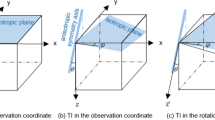Abstract
Imaging the PP- and PS-wave for the elastic vector wave reverse-time migration requires separating the P- and S-waves during the wave field extrapolation. The amplitude and phase of the P- and S-waves are distorted when divergence and curl operators are used to separate the P- and S-waves. We present a P- and S-wave amplitude-preserving separation algorithm for the elastic wavefield extrapolation. First, we add the P-wave pressure and P-wave vibration velocity equation to the conventional elastic wave equation to decompose the P- and S-wave vectors. Then, we synthesize the scalar P- and S-wave from the vector Pand S-wave to obtain the scalar P- and S-wave. The amplitude-preserved separated P- and S-waves are imaged based on the vector wave reverse-time migration (RTM). This method ensures that the amplitude and phase of the separated P- and S-wave remain unchanged compared with the divergence and curl operators. In addition, after decomposition, the P-wave pressure and vibration velocity can be used to suppress the interlayer reflection noise and to correct the S-wave polarity. This improves the image quality of P- and S-wave in multicomponent seismic data and the true-amplitude elastic reverse time migration used in prestack inversion.
Similar content being viewed by others
References
Aki, K., and Richards, P. G., 1980, Quantitative seismology, theory and methods: W. H. Freeman and Co, San Francisco.
Berenger, J. P., 1994, A perfectly matched layer for the absorption of electro-magnetic waves: Journal of Computational Physics, 114, 185–200.
Cervený, V., 2001, Seismic ray theory: Cambridge University Press, England.
Chang, W. F., and McMechan, G. A., 1987, Elastic reversetime migration: Geophysics, 52(10), 1365–1375.
Chang, W. F., and McMechan, G. A., 1994, 3D elastic prestack reverse-time depth migration: Geophysics, 59(4), 597–609.
Chattopadhyay, S., and McMechan, G. A., 2008, Imaging conditions for reverse time migration: Geophysics, 73(3), S81–S89.
Chen, T., and He, B. S., 2014, A normalized wavefield separation cross-correlation imaging condition for reverse time migration based on Poynting vector: Applied Geophysics, 11(2), 158–166.
Dong, L. G., Ma, Z. T., Cao, J. Z., et al., 2000, A staggeredgrid high-order difference method of one-order elastic wave equation: Chinese Journal of Geophysics(in Chinese), 43(3), 411–419.
Du, Q. Z., Zhang, M. Q., Chen, X. R., Gong, X. F., and Guo, C. F., 2015, True-amplitude wavefield separation using staggered-grid interpolation in the wavenumber domain: Applied Geophysics, 11(4), 437–446.
He, B. S., and Zhang. H. X., 2006, Vector prestack depth migration of multi-component wavefield: Oil Geophysical Prospecting (in Chinese), 41(4), 369–374.
Li, Z. Y., Liang, G. H., and Gu, B. L., 2013, Improved method of separating P-and S-waves using divergence and curl: Chinese Journal of Geophysics (In Chinese), 565(6), 2012–2022.
McMechan, G. A., 1989, A review of seismic acoustic imaging by reverse-time migration: International Journal of Imaging Systems and Technology, 1(1), 18–21.
Mu, Y. G., and Pei, Z. L., 2005, Seismic numerical modeling for 3-D complex media: Petroleum Industry Press, China (in Chinese).
Sun, R., 1999, Separating P-and S-waves in a prestack 2-dimensional elastic seismogram: 61st Conference, European Association of Geoscientists and Engineers, Extended Abstracts, 6–23.
Sun, R., Chow, J., and Chen, K. J., 2001, Phase correction in separating P-and S-waves in elastic data: Geophysics, 66(5), 1515–1518.
Sun, R., and McMechan, G. A., 2001, Scalar reversetime depth migration of prestack elastic seismic data: Geophysics, 66(5), 1519–1527.
Sun, R., McMechan, G. A., and Chuang, H., 2011, Amplitude balancing in separating P and S-waves in 2D and 3D elastic seismic data: Geophysics, 76(3), S103–S113.
Sun, R., McMechan, G. A., Hsian, H., and Chow, J., 2004, Separating P-and S-waves in prestack 3D elastic seismograms using divergence and curl: Geophysics, 69(1), 286–297.
Sun, R., McMechan, G. A., Lee. C. S., et al., 2006, Prestack scalar reverse-time depth migration of 3D elastic seismic data: Geophysics, 71(5), 199–207.
Wang, W. L., and McMechan, G. A., 2015, Vector-based elastic reverse time migration: Geophysics, 80(6), S245–S258.
**ao, X., and Leaney, W. S., 2010, Local vertical seismic profiling (VSP) elastic reverse-time migration and migration resolution — Salt-flank imaging with transmitted P-to-S waves: Geophysics, 75(2), S35–S49.
Yan, R., and **e, X., 2012, An angle-domain imaging condition for elastic reverse time migration and its application to angle gather extraction: Geophysics, 77(5), S105–S115.
Yoon, K., and Marfurt, K. J., 2006, Reverse-time migration using the Poynting vector: Exploration Geophysics, 37, 102–107.
Zhang, Q., and McMechan, G. A., 2011, Common-image gathers in the incident phase-angle domain from reverse time migration in 2D elastic VTI media: Geophysics, 76(6), S197–S206.
Author information
Authors and Affiliations
Corresponding author
Additional information
This work is supported by Special Research Grant for Non-profit Public Service (No. 201511037), National Natural Science Foundation of China (No. 41504109, 41506084, and 41406071), China Postdoctoral Science Foundation (No. 2015M582060), and Qingdao Municipal Applied Research Projects (No. 2015308).
Yang Jia-Jia, got her PhD Degree in geophysical prospecting from Ocean University of China in 2015. Now she works in Qingdao Institute of Marine Geology as a post-doctoral. Her research interests are seismic wave theory, multi-technology and multi-component seismic wave reverse-time depth migration.
Rights and permissions
About this article
Cite this article
Yang, JJ., Luan, XW., Fang, G. et al. Elastic reverse-time migration based on amplitude-preserving P- and S-wave separation. Appl. Geophys. 13, 500–510 (2016). https://doi.org/10.1007/s11770-016-0571-z
Received:
Revised:
Published:
Issue Date:
DOI: https://doi.org/10.1007/s11770-016-0571-z




